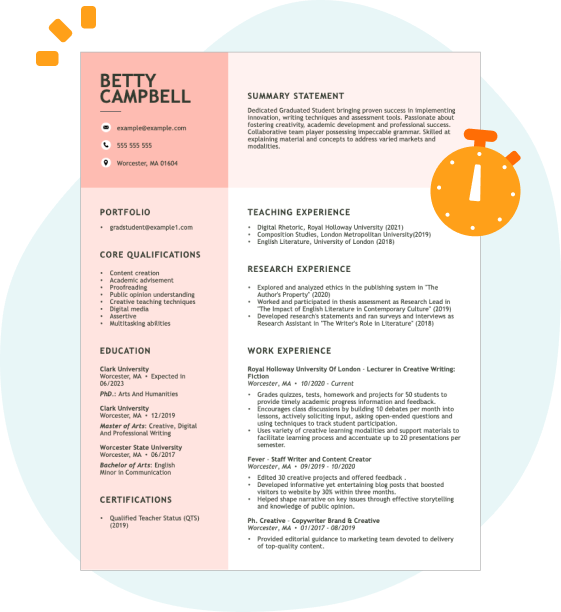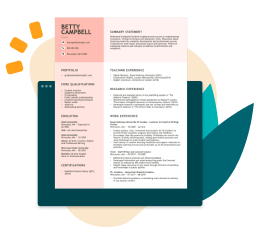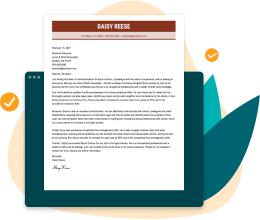Hard skills are technical abilities such as diagnosing illnesses, performing medical procedures, and interpreting diagnostic tests that are essential for a doctor's effectiveness in providing care.
Popular Doctor Resume Examples
Check out our top doctor resume examples that emphasize critical skills such as diagnosis, patient management, and communication. These examples will help you effectively showcase your accomplishments to potential employers.
Ready to build your ideal resume? Our Resume Builder offers user-friendly templates specifically designed for medical professionals, helping you shine in your job applications.
Entry-level doctor resume
This entry-level resume for a doctor effectively highlights the applicant's clinical skills and notable accomplishments during their medical training, showcasing their ability to improve patient outcomes and engage in research. New professionals must demonstrate a strong foundation in patient care, research capabilities, and relevant certifications to appeal to employers despite limited direct work experience.
Mid-career doctor resume
This resume effectively presents key qualifications that showcase the job seeker's extensive experience and leadership skills. By highlighting achievements in patient care and team management, it positions them as a capable doctor ready for advanced responsibilities and challenges.
Experienced doctor resume
This section highlights the applicant's extensive experience as a doctor, showcasing their ability to diagnose and treat over 1,500 patients annually while leading a team that reduced ER wait times by 25%. The clear formatting allows hiring managers to quickly assess key accomplishments and expertise.
Resume Template—Easy to Copy & Paste
Chris Chen
Northwood, OH 43620
(555)555-5555
Chris.Chen@example.com
Skills
- Patient Care
- Surgical Expertise
- Healthcare Management
- Telemedicine
- Team Leadership
- Disease Prevention
- Clinical Research
- Treatment Protocol Optimization
Certifications
- Board Certified in Internal Medicine - American Board of Internal Medicine
- Advanced Cardiovascular Life Support - American Heart Association
- Pediatric Advanced Life Support - American Academy of Pediatrics
Languages
- Spanish - Beginner (A1)
- French - Beginner (A1)
- Mandarin - Beginner (A1)
Professional Summary
Experienced doctor specializing in patient care, surgery, healthcare management, and treatment protocol optimization, with a proven track record in increasing patient satisfaction rates, leading health initiatives, and published research.
Work History
Doctor
Harmony Health Center - Northwood, OH
January 2023 - November 2025
- Led team to improve patient outcomes by 35%
- Administered over 500 successful surgeries
- Optimized treatment protocols, reducing costs 20%
Medical Consultant
Riverside Medical Group - Cincinnati, OH
May 2020 - December 2022
- Increased patient satisfaction by 40%
- Coordinated health programs, saving 100K
- Expanded telehealth reach by 50% annually
Healthcare Specialist
Meadowbrook Clinic - Cincinnati, OH
January 2019 - April 2020
- Managed care for 200+ chronic patients
- Implemented wellness initiatives improving fitness
- Collaborated in outreach reducing hospital visits
Education
Doctor of Medicine Medicine
Harvard Medical School Cambridge, MA
June 2018
Bachelor of Science Biology
University of California, Berkeley Berkeley, CA
June 2014
How to Write a Doctor Resume Summary
Your resume summary is the first impression you make on hiring managers, so it needs to be compelling and clearly demonstrate your qualifications. As a doctor, you should emphasize your clinical skills, patient care experience, and any specialized training that sets you apart.
Highlighting your ability to diagnose, treat, and manage patient care is important in this profession. You want employers to see not just your medical expertise but also your commitment to improving patients' lives.
To illustrate what works in creating an effective resume summary for doctors, here are some examples that will guide you in crafting yours:
Weak resume summary
I am a dedicated doctor with many years of experience in various medical fields. I seek a position that allows me to use my skills effectively while maintaining a healthy work-life balance. A supportive team and room for advancement are what I desire in my next role.
- Lacks specific details about the applicant's expertise or specialties, making it vague
- Overuses personal pronouns and subjective language, which detracts from professionalism
- Emphasizes the applicant's needs rather than highlighting how they can contribute to the healthcare facility
Strong resume summary
Compassionate doctor with 7 years of experience in internal medicine, focusing on chronic disease management and preventive care. Achieved a 20% improvement in patient satisfaction scores through improved communication strategies and personalized treatment plans. Proficient in electronic health records, diagnostic imaging, and collaborating with healthcare teams to optimize patient outcomes.
- Begins with clear experience level and specialization area
- Includes quantifiable achievement that reflects significant impact on patient care and satisfaction
- Highlights specific technical skills that are critical for the role of a doctor
PRO TIP
Showcasing Your Work Experience
The work experience section is the cornerstone of your resume as a doctor. This area will contain the majority of your content, and good resume templates always emphasize this important section.
Organize this part in reverse-chronological order to highlight your most recent roles. Use bullet points to succinctly describe your key achievements and contributions in each position you’ve held.
To further clarify what makes a strong work history, we’ll provide examples that illustrate effective entries for doctors. These examples will showcase what captures attention and what should be avoided:
Doctor
City Medical Center – New York, NY
- Provided patient care.
- Performed examinations and treatments.
- Collaborated with medical staff.
- Documented patient information.
- Lacks specific dates of employment
- Bullet points are overly general and fail to highlight unique skills or achievements
- Emphasizes routine duties rather than powerful contributions or results
Doctor
City Medical Center – New York, NY
June 2020 - Current
- Diagnose and treat a diverse patient population in a busy outpatient clinic, seeing over 30 patients daily.
- Implement preventive care strategies that improved patient adherence to treatment plans by 40% within one year.
- Mentor medical students during their clinical rotations, improving their practical skills and knowledge application.
- Uses powerful action verbs at the beginning of each bullet point to highlight achievements
- Incorporates specific metrics that demonstrate the impact of the applicant's work
- Showcases relevant skills and responsibilities that align with common expectations for doctors
While your resume summary and work experience are important, don’t overlook the significance of other sections. Each part plays a key role in presenting your qualifications effectively. For a detailed guide on crafting your resume, explore our comprehensive how to write a resume resource.
Top Skills to Include on Your Resume
A well-defined skills section is important for a compelling resume. It allows potential employers to quickly assess whether you possess the necessary qualifications for the doctor role.
Strengthen your resume by including a balanced mix of hard and soft skills.
Interpersonal attributes like active listening, empathy, and teamwork are considered soft skills and foster strong patient relationships while improving collaboration among healthcare professionals.
When selecting your resume skills, it's important to align them with what employers expect. Many organizations use automated systems that filter out applicants lacking essential skills for the position.
To effectively tailor your resume, carefully review job postings for insight into which skills are most valued. This approach not only helps you stand out to recruiters but also ensures your application meets the criteria set by ATS systems.
PRO TIP
10 skills that appear on successful doctor resumes
Highlighting key skills on your resume can significantly improve your appeal to recruiters in the medical field. By showcasing these high-demand abilities, you demonstrate your suitability for the role and increase your chances of standing out. By the way, our resume examples illustrate how these skills can be effectively presented.
Consider integrating the following 10 essential skills into your resume if they match your experience and job criteria:
Diagnostic ability
Patient care
Team collaboration
Attention to detail
Time management
Knowledge of pharmacology
Interpersonal communication
Crisis intervention
Surgical assistance
Health education
Based on analysis of 5,000+ medical professional resumes from 2023-2024
Resume Format Examples
Choosing an appropriate resume format is important for doctors, as it effectively showcases their medical expertise, relevant experiences, and professional growth in a clear and effective manner.
Functional
Focuses on skills rather than previous jobs
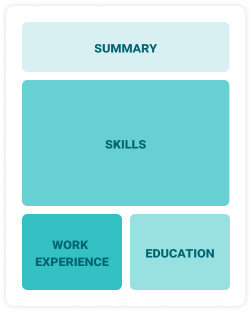
Best for:
Recent graduates and career changers with up to two years of experience
Combination
Balances skills and work history equally
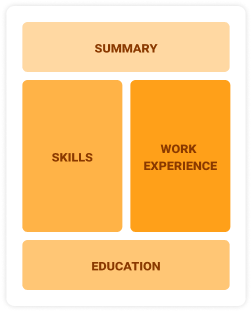
Best for:
Mid-career professionals focusing on their skills and future opportunities
Chronological
Emphasizes work history in reverse order
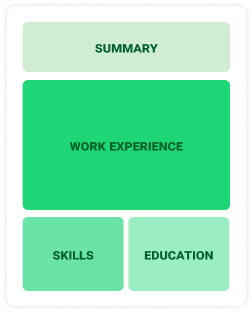
Best for:
Seasoned experts leading innovative healthcare teams
Frequently Asked Questions
Should I include a cover letter with my doctor resume?
Absolutely, including a cover letter is essential for showcasing your passion and qualifications. It allows you to personalize your application and highlight why you're a great fit for the position. If you need assistance, consider our comprehensive guide on how to write a cover letter or use our easy-to-navigate Cover Letter Generator to streamline the process.
Can I use a resume if I’m applying internationally, or do I need a CV?
When applying for jobs outside the U.S., use a CV instead of a resume, as it's often the preferred format. For guidance on crafting an effective CV, explore our resources that provide CV examples and tips to ensure your document meets international standards. Additionally, understanding how to write a CV can be invaluable in tailoring your application for global opportunities.
What soft skills are important for doctors?
Soft skills such as empathy, active listening, and teamwork are essential for doctors. These interpersonal skills foster trust with patients and promote collaboration among healthcare professionals, ultimately improving patient care and treatment outcomes.
I’m transitioning from another field. How should I highlight my experience?
Highlight your transferable skills such as communication, empathy, and teamwork from previous roles. These abilities showcase your potential to excel in a medical environment, even if you lack direct healthcare experience. Share specific instances where you've applied these skills to demonstrate how they align with the responsibilities of a doctor and your commitment to patient care.
How should I format a cover letter for a doctor job?
To format a cover letter for doctor positions, begin with your contact details. Follow this with a professional greeting and an engaging introduction that highlights your passion for medicine. Include a concise overview of your relevant experience and skills. It's important to align your content with the specific job requirements and conclude with a strong call to action.
How do I write a resume with no experience?
If you're applying for doctor positions with limited experience, consider using a resume with no experience to effectively highlight your clinical clerkships, internships, and relevant coursework. Emphasize your research projects, leadership roles in student organizations, and any volunteer work in healthcare settings. Your passion for medicine and dedication to patient care can shine through, as employers value potential and a strong commitment to learning.


